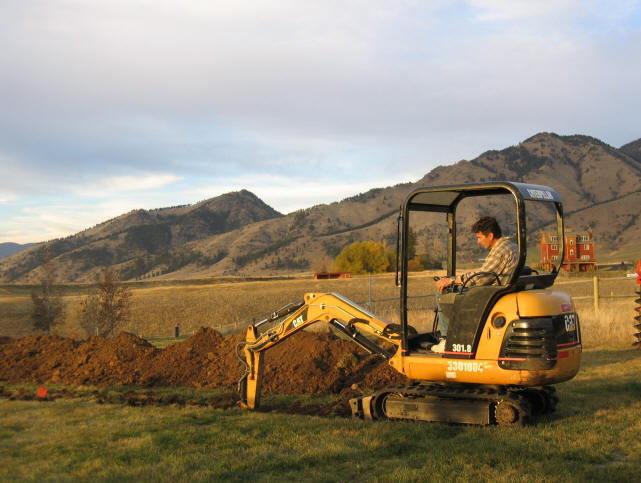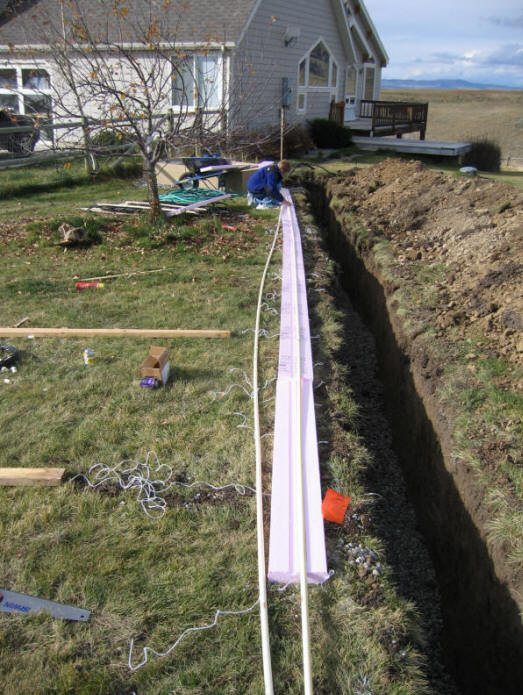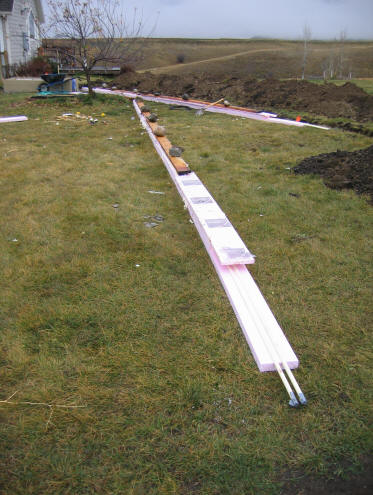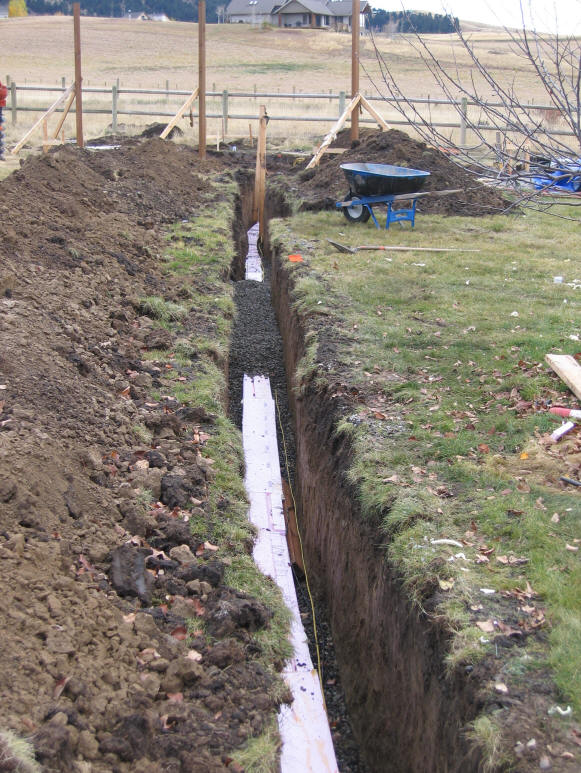
Search
The Renewable Energy site for Do-It-Yourselfers
Solar Shed -- Heat Transfer
Trench
|
Heat is transferred from the storage
tank in the Solar Shed to the house via two 3/4 inch CPVC pipes. The pipes
are buried in a 4.5 ft deep trench that runs from the shed to the house crawl
space. The pipes are insulated to around R15 by enclosing them in rigid
polystyrene foam board (see pictures). The pipes are installed in
the trench by 1) laying down a 3 inch bed of screened gravel, 2) laying the
insulated pipe assembly on the bed of gravel, 3) filling around the pipe with
more screened gravel, 4) adding a covering 6 mil poly on top of the gravel, and
5) backfilling dirt to fill the trench.
I used extruded polystyrene ("pink"
foam) because it is used
routinely for foundation insulation, and (I believe) will hold up to the outside
environment without deterioration or excessive moisture absorption. The
thinking behind the gravel is that it provides a dry environment for the
pipe/insulation assembly to live in, and may provide some additional insulation
value.
The pipes are buried 4 ft deep to
ensure that they are below the frost line, and to take advantage of the somewhat
warmer ground temperature as you go down. I may have gone a bit overboard
on this -- one concern was that the shed is about 120 feet from the house, and I
wanted to make sure that there was not excessive heat loss on the trip (see
calcs below). |
|

Digging the trench with a rented
mini-excavator, and gaining a whole new respect for the skills of a good backhoe
operator.

Placing the CPVC pipe into the
polystyrene foam boards. This is the bottom board. It has two
grooves dadoed into it to accept the two pipes. Polyurethane foam
("Great Stuff" cans) was then applied to the top of this foam board, and a 2nd foam
board with the grooves facing down was place over it. The foam
glues the two foam boards together, and seals any gaps. The strings are to
tie the two halves together while the foam is curing. The foam expands as
it cures, so the boards need to be held together while it is curing.
An alternative to the dadoed grooves
would be to use 1 inch thick foam to space the top and bottom foam boards far
enough apart to run the two pipes between.
The foam boards are extruded
polystyrene (the pink or blue stuff), and are 8 inches wide. The cost for
insulating the two pipes is about $1.30 per foot. I think it does at least
as well as some of the $7 per foot commercial schemes.

Scraps of one inch thick foam board
are foam glued over the top of the two two inch thick foam boards just to
provide some more insulation. This method of placing boards over the
foam boards, and weighting them with rocks while the liquid foam is curing is
easier than the tie strings in the previous picture.

Insulated pipes placed in trench with
gravel under and over. A layer of 6 mil poly was placed over the gravel
before backfilling the trench. The wires are for some sensors that will
monitor the performance of the system. You will probably want to include
wires for the sensors that your differential controller will need, so that the
controller can be mounted in the house. You may also want to include an AC
power line to run the pump -- check your codes on this. Be sure to do a pressure and flow test at this
stage to make sure the pipes don't leak, and have no blockages -- its a lot of
work to dig the trench -- you don't want to have to do it twice.
I used CPVC pipes because I do not
expect the storage tank temperature to go much above 160F, and this is well within
the capability of CPVC, especially given that the pressure in the system will be
low. The CPVC will be living in a fairly friendly environment with the
foam board and gravel surrounding it. PEX would be another candidate, and
(I think) would also work well -- I picked the CPVC over the PEX mostly because
I thought it would be a hassle to install a big coil of PEX in the foam board
grooves.

To get the pipe line through the
concrete foundation wall, I rented a rotating hammer drill with a 3 inch core
bit.
I drilled three holes: one for
the two Solar Shed pipes, a 2nd for the some wires that go from the house to the
Solar Shed (these are for sensors, and maybe pump power), and a 3rd for the
eventual horizontal pond solar water heater project. Dusty, but fast.

Picture from inside the crawl space.
Picture from outside where the trench
comes into the house --->
Heat transfer capability:
I wanted a sufficiently large pipe to
be able to transfer all the the heat that can be collected in a day and/or
stored in the 500 gallon storage tank to be transferred to the house in a
reasonable time:
Day heat collection:
Qday = (1900 BTU/day-ft^2)(240
ft^2)(0.5 efic) = 230K BTU/sunny day
Where 1900 BTU is the solar
radiation incident on 1 sqft of a 70 deg sloped surface in Nov on a sunny
day at 46 deg N latittude.
Storage Tank Capacity:
Qstor = (500 gal)(8.2
lb/gal)(150F - 90F)(1 BTU/lb-F) = 250K BTU
For a 3/4 inch pipe:
There is about 250 ft of pipe (round
trip)
At 3 gpm, the head loss for 250 ft of
3/4 inch pipe is (2.5)(2.19 ft/100ft) = 5.5 ft of head loss
This seems easily in the range of the
common Grundfos and Taco ciruclation pumps.
The heat transfer rate at 3 gpm with
a 10F temperature drop in the house radiators is:
Qhouse = (3 gal/min)(10F) (60
min/hr)(8.2lb/gal) (1 BTU/F-lb) = 15K BTU/hr
Or, about 230K/15K = 15 hrs to
transfer a full sunny day of collection to the house.
Seems about right?
The heat loss rate of the house is
about 400 BTU/hr-F, so at 30F outside:
QhouseLoss = (400BTU/hr-F)(65F-30F) =
14K BTU/hr
Or, about the same as the pipe can
easily transfer. I hope to get the house loss late down to more like 300
BTU/hr-F with some improvements in insulation and further weatherizing.
Heat loss rate from the pipe:
The heat loss while fluid is flowing
through the pipe is relatively small with the R15 pipe insulation:
..
When the pump turns off, the fluid in
the line starts cooling off. If you assume (at worst) that it cools down
to around ground temp, then you lose the heat that was stored in the pipe fluid:
Qpipe = (250ft) (0.02gal/ft)
(120F-50F)(8.2lb/gal)(1BTU/lb-F) = 2900 BTU
Or, about 1% of a sunny days
collection.
Not too bad(?), but, It might be
better than this due to the two pipes being enclosed together, the insulation
offered by the gravel and ground, and the time constant of the cooling fluid.
----
1/15/07 update
The temperature sensor that I buried
in the trench near the pipe has settled down to about 38F to 40F -- a bit colder
than I expected at 4 ft down. When the pipe from the storage tank to the
house is used to transfer water for several hours, the trench temperature goes
up a couple degrees, and then drifts back down to about 40F in 10 hours or so.
Gary Updated 10/25/06, 1/15/07
